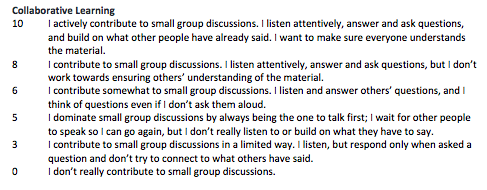This spring, I’m teaching a graduate seminar for the first time in four years. At its height, it had 17 people enrolled, although it’s settled down in 14. Given that I’m also teaching an upper-division undergrad class with 24 people, and I need to get more research done than I did last semester, I spent some time over winter break considering a) what work I was going to require of my students and b) what grading that was going to require of me.
As part of this, I did a quick Google search for the syllabi I could find for graduate seminars in geography. Most classes and their syllabi have disappeared into the classroom management system void, but I still found about a dozen from the past couple of years that I could model. I wanted to get a sense of what was required and how it was weighted. Without giving away courses, institutions, or instructors, here are the models I found:
- Participation: 30%
Lead two discussions: 30%
Essay (2500-3000 words, based on at least five readings): 40% - Participation
Evaluation of others (this is in my notes, I’m not sure what it means)
Three 2-3 page reviews of supplemental materials
“Review-and-agenda” paper of 15-25 double-spaced pages with 20 references
Progress reports on the paper
15-minute class presentation on the paper - Participation: 25%
Lead discussion: 25%
Term paper (5000 words): 50% - Participation: 40%
Weekly QAQC paper (quotation, argument, question, connection): 30%
Essay (10 pages): 30% - Participation: 20%
Two exegises: 20%
Lead two discussions: 20%
Either one or two papers, 20-24 double-spaced pages total: 40% - Participation: 50%
Exhibit: 15%
Term paper: 35% - Participation: 20%
Presentation/facilitation: 10%
Four outlines, four reaction papers: 20%
Term paper (4000-5000 words), including peer review: 50% - Participation: 20%
Term paper (12-15 pages)
10-15 minute presentation - Six reaction papers: 33%
Term paper (6000 words or 22 double-spaced pages): 66% - Participation: 15%
Weekly reaction paper and leading two discussions: 20%
Paper proposal: 5%
Term paper (6000 words): 50%
15-minute presentation: 10% - Participation: 25%
Lead discussion: 10%
Weekly reaction paper: 20%
Paper proposal: 5%
Term paper (15-25 pages): 30%
10-minute presentation: 10%
Some thoughts:
- Wow, is that a lot of variation in how much participation counts.
- I thought weekly reaction papers were de rigueur, but only about a third of these classes require them. Is that to save on grading?
- There’s also a lot of variation in length of the term papers, and in how structured their assignments are.
What I came up with based on a combination of these and my desire to keep the volume of grading under control so I could do it in a timely fashion was this:
Participation: 15% (self-assessed)
Weekly reaction paper: 25% (started off in the QAQC format, but now is more open)
Lead discussion once in a team of two: 10% (many grad students have never led a class discussion, so I thought partnering up would help)
10-minute presentation on a book not on the syllabus: 10% (that way we get to hear about a lot of different books that are out there while primarily reading articles)
Short term paper 1: case study of an activist organization or issue: 20% (to apply theories from class to a real-life case, but also to understand that “mobility justice” predates academia)
Short term paper 2: review-and-agenda paper: 20% (to identify what literature is most useful for thesis/paper projects)
How does this compare to your recent graduate seminars, either as a teacher or a student?




